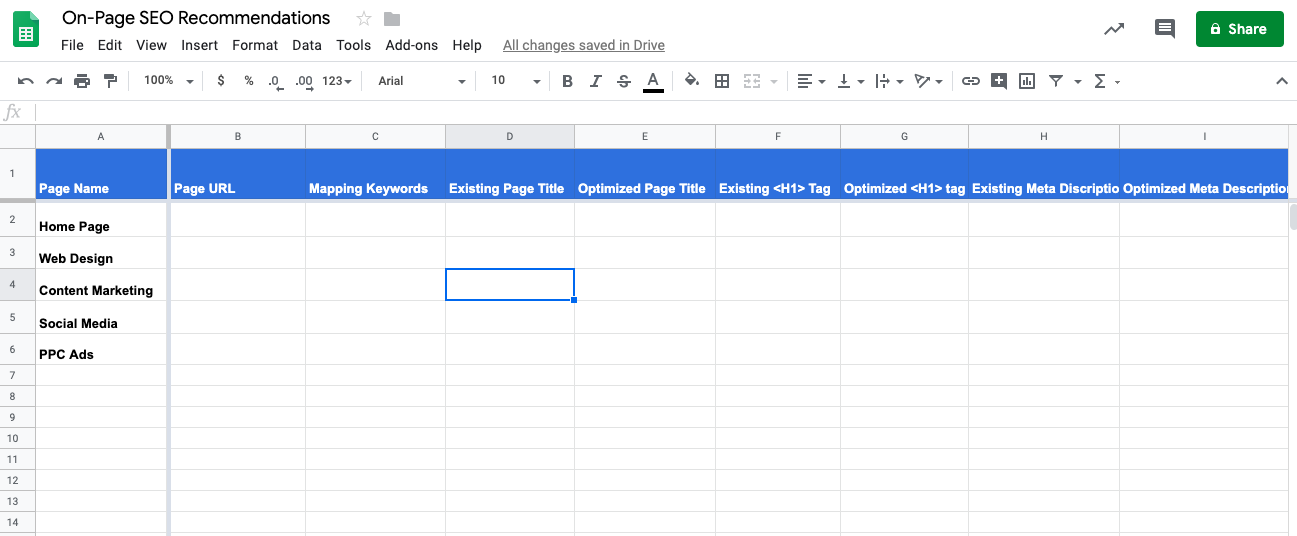Depending on your industry and/or how you’ve designed your website, it’s quite possible the majority of keyword searches won’t result in potential customers landing on your home page. Those searchers may be asking a question that leads them to a recent blog post or service page that is more applicable.
That’s why, whether you have a large website or one with only a few main pages, a keyword map is critical to the overall success of your SEO strategy.
With a good keyword map, you’ll be able to leverage the full power of your website’s potential.
So What is a Keyword Map?
Essentially, a keyword map is like a blueprint for building effective SEO by using the right keywords. It takes your valuable keyword research and outlines how you can optimize each page of your website and create new content that will draw new organic searches to your site.
Based on the results of this blueprint, you can then make on-page SEO changes that can make the difference between a page not ranking at all, to one that’s suddenly ranking for highly searched terms.
Here’s How You Go about Keyword Mapping
First, if you’ve got a large website, this process could feel a little daunting. But if you break it down and build your keyword map step-by-step, one section at a time, the process is doable. For example, you could begin with certain product or service pages and move on to the rest of the site from there.
Do Some Keyword Research
Even if you’ve taken the time to do keyword research in the past, we encourage you to go through this process with specific pages in mind. What keywords that aren’t currently ranking for you do you want your site to appear for?
Once you gather your research, you’ll probably have a mixture of shorter keywords and long tail keywords. Long tail keywords are three or four-word phrases that are more targeted and may have a lower search volume. But they can still be quite powerful in converting searchers into customers.
Next, gather your keywords together into groups that answer the same question or have to do with relatively the same topic. These groupings are useful in three ways: optimizing for a current page, realizing a content-hole in your website that needs a new page, or mapping out blog content.
Create Your Keyword Mapping Document
Most keyword maps are created in Excel or Google Spreadsheets. You might call it a Keyword Map, or you could name it an On-Page Optimization Document or SEO Change Document.
The number of columns your document could potentially have is endless. If you’re a beginner to Keyword mapping, we’ll suggest 9 columns to get your feet wet.
- In column one, put the name of the page
- In column two, put the page’s URL
- In column three, insert the keywords you’ve determined you want to rank for
- In column four: the existing page title
- In column five: the new optimized page title (it may or may not be different)
- In column six: the page’s current <H1> tag
- In column seven: the new optimized <H1> tag
- In column eight: the current meta description
- In column nine: the new optimized meta description
Here’s a bare-bones example

Take it a Step Further
The above suggestions are a really basic way to use a keyword map. But remember that SEO and ranking are about much more than just using keywords smartly.
If you or someone you’ve hired to take care of your SEO needs has a little more time on their hands, then you might expand on this and more thoroughly tackle page optimization.
Additional categories you can track include: page speed, page authority (PA), external links, internal links, engagement, Google desktop ranking, Google mobile ranking, organic visits—and the list goes on.
With these categories, you can get a greater sense of what might help boost a page’s ranking and visibility.
If you have further questions about keyword mapping or you’re feeling like you need a bit of help in this department, contact us at New Wine Digital today. We’ll do the heavy SEO lifting for you and help get your website noticed by more potential customers!
Image by Wokandapix from Pixabay (4/3/2019)
